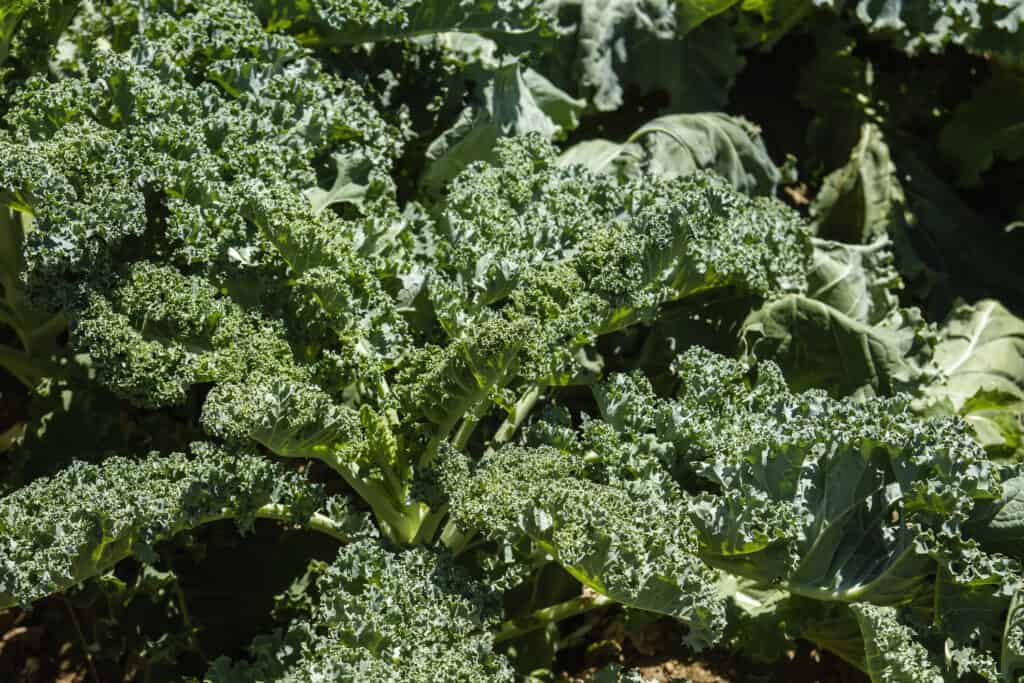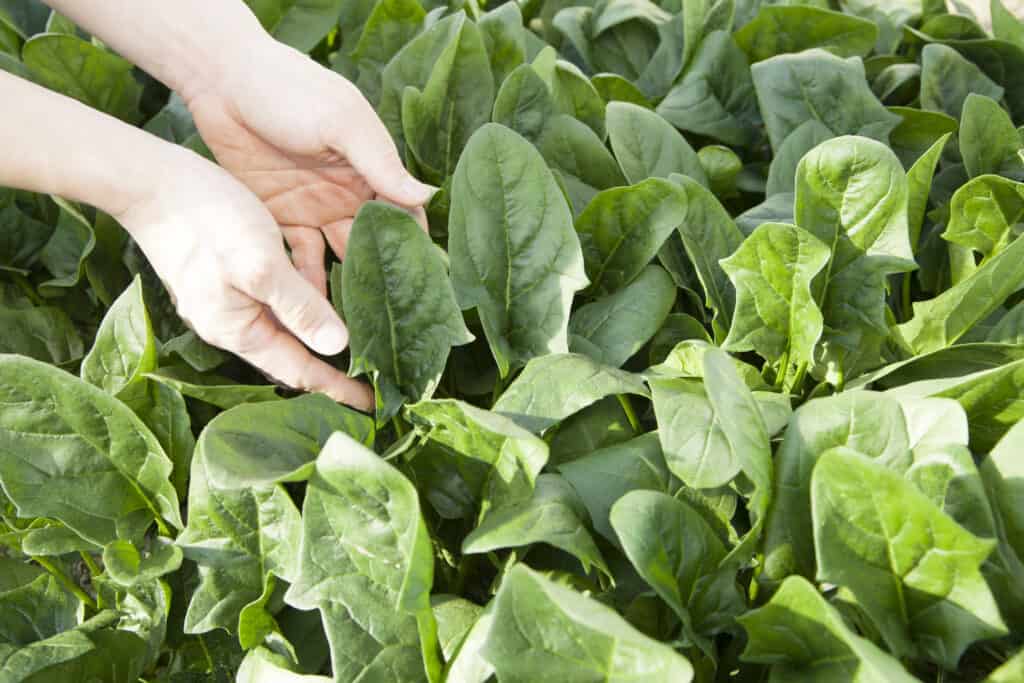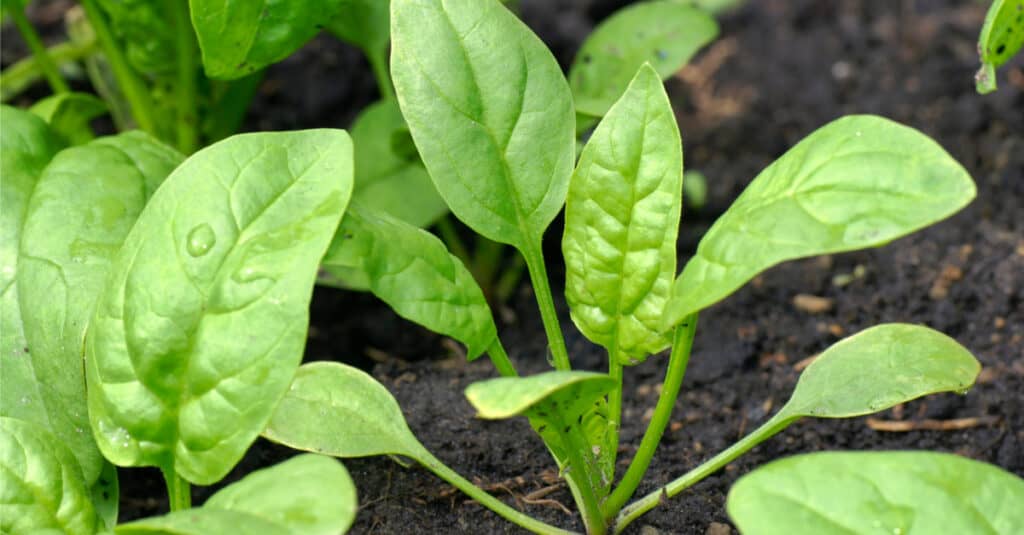Kale and spinach are both dark leafy greens known for being full of fiber, rich in antioxidants, and a great source of nutrition. Dark green leafy vegetables like kale and spinach are popular both cooked and uncooked, and often form the base of nutrient-rich salads. They are also both popular additions to green juice blends and smoothies.
Here are just a few of their similarities:
- Both kale and spinach are edible, leafy green plants
- Both kale and spinach are hardy vegetable crops popular among home gardeners
- Both kale and spinach tolerate the cold and do well when planted in early spring or late fall, but do not thrive in hot temperatures
- Both kale and spinach are known to be rich in vitamins A, C, E, and K
- Both kale and spinach contain high levels of fiber, iron, magnesium, potassium, and calcium
However, there are also some key differences between kale and spinach plants that keep them distinct. Keep these differences in mind when planting, growing, and harvesting kale or spinach, and when deciding which to add to your lunch salad! Let’s learn more about spinach and kale, where they come from, their history, and more about their appearance, taste, growing environments, and uses in daily life.
Comparing Kale vs. Spinach
| Characteristic | Kale | Spinach |
|---|---|---|
| Scientific Name | Brassica oleracea var. acephala | Spinacia oleracea |
| Family | Brassicaceae | Amaranthaceae |
| Common Name | Kale | Spinach |
| Description of Plant | Kale is a cabbage cultivar that grows in a rosette of long leaves with ruffled or frilly edges. Kale leaves vary in color depending on the particular variety, ranging in color from dark green to light green, dark purple, or reddish-brown. Kale’s main stem may grow to be 20 to 24 inches tall or longer, with leaves typically growing 18 inches long and up to 12 inches wide. Depending on the variety, kale may be an annual or biennial. | Spinach is an herbaceous annual plant that grows with alternate, simple leaves from a central stem and reach up to 12 inches long and 6 inches wide. Spinach leaves are bright to dark green and are oval-shaped, soft leaves. Light green spinach leaves signal a lack of nutrients in the soil where the spinach plant is growing. |
| Taste and Texture | Kale may be described as earthy, crunchy, and dry. It may also be sweet, mild, or bitter depending on the growing conditions and temperature. Cooked kale can become more tender and milder than when it is raw. | Spinach has a mild, sweet taste. It is sometimes described as “grassy” or earthy and soft when fresh. The stems are crunchy or crisp. Spinach’s high iron content may give the leaves a somewhat metallic flavor. Cooked spinach is soft. It may also have a stronger, more acidic or bitter flavor. |
| Uses | Kale may cooked, frozen and reheated, or eaten raw. As a leafy green vegetable, it is commonly chopped or torn into small pieces to be used as a base for salads. Because kale is full of important nutrients, it is often sold as a “health food” and made into dietary supplements, added to protein powders, baked and packaged to be sold as a “kale chips” snack, and integrated into smoothies or green juices. | Spinach may be cooked, frozen and reheated, or eaten raw. Like kale, spinach is a leafy green vegetable that often forms the base for salad or is added to salad mixtures. Spinach has many of the same nutrients as kale and is similarly sold as a “super food” and as an ingredient in dietary supplements, smoothies, and green juices. However, some research suggests that cooking spinach will allow you to absorb a greater amount of nutrients. |
Kale vs. Spinach: Description
Kale
Kale is a variation of the Brassica oleracea species in the Brassicaceae family. Brassica oleracea also includes broccoli, brussels sprouts, cauliflower, collard greens, and several other common cultivars. These “cabbage” crops are a staple crop that people have cultivated for centuries. Kale, specifically, grows with wide leaves that ripple or curl on the edges from a central stem. Most varieties are annual plants, planted from seed during the spring, fall, or winter. However, among the multiple kale varieties include a few that are biennial and will grow leaves in the first year followed by flowers and seeds in the second.
Different kale varieties will manifest unique physical characteristics, with leaf colors that vary from dark green to purple or even brown, and growth to varying stem heights. The main kale stem of each plant will grow up to 24 inches tall or longer, with the typical leaf growing to be up to 18 inches long and up to 12 inches wide. Depending on the variety, kale may be an annual or biennial, with biennial plants forming a flower stalk that seeds.

The main kale stem of each plant will grow up to 24 inches tall or longer, and different varieties will have unique physical characteristics such as color and height.
©iStock.com/jessicahyde
Spinach
Spinach, or Spinacia oleracea, is a member of the Amaranthaceae family. Amaranthaceae, commonly known as the “amaranth family,” includes more than 160 genera and over 2,000 species. Spinach is part of the sub-family Chenopodioideae, a flower plant family that also includes 26 genera. Spinacia oleracea is an annual plant that grows simple leaves from a central stem. Each oval-shaped spinach leaf may grow to be up to a foot long and half a foot wide, though they are typically smaller. Spinach leaves have a soft, delicate surface and stiff stem. Healthy spinach will be dark green or a vibrant bright green, with lighter-green color an indication that the plant is growing in soil without sufficient nutrients.
Many confuse the leafy, red-tinged leaves of “red spinach” as Spinacia oleracea. However, red spinach is actually the colloquial name for both Amaranthus dubius (“Chinese spinach”) or Blitum rubrum (Red Goosefoot), other members of the Amaranthaceae family. In 2019, USDA Red, the world’s “first true red spinach variety” was announced as a variety of the Bordeaux spinach variety.

Healthy spinach will be dark green or a vibrant bright green in color.
©iStock.com/okugawa
Key Differences Between Kale vs. Spinach
As you can see, these two plants have a lot in common. They share similarities in how they are grown, their dietary benefits, and how they are consumed. The most significant differences between kale and spinach have to do with their histories, cultivation, appearance, and taste. Let’s explore some of those similarities and differences now.
Kale vs. Spinach: History
Kale is native to Euro-Asia but has been cultivated and consumed by humans for thousands of years. There are records dating back to the ancient Greeks and Romans. The historical records include references to vegetables in the cabbage family. They also have instructions for how to use leafy greens for their health benefits. More recently, since the Middle Ages, kale has been popular across European and Asian cultures. The major types of kale that we have today come from countries like Italy, Scotland, and Russia developing unique varieties to withstand different climates and grow with unique physical features.
Spinach, on the other hand, originated in the region now known as the Middle East, in ancient Persia, the geography we now know as Iran. Historians estimate that it was first domesticated in Persia, now Iran, about 2,000 years ago. The earliest records of spinach cultivation are from the fourth century AD, in ancient Mesopotamia. Though we do not know exactly how spinach spread, the first records indicate its presence in China in the 600s and Spain in the 1000s. In China, it gained popularity as “Persian Green” or “Persian Vegetable.” By the 1400s and 1500s, Spinach had spread throughout Europe and was cultivated in countries including England, France, and Italy. Eventually, European colonization brought it to North America. Today, farmers and gardeners grow spinach all over the world.

Spinach originated in ancient Persia roughly 2,000 years ago.
©iStock.com/SylvieBouchard
Kale vs. Spinach: Major Varieties
Today’s kale varieties come from older forms of cabbage that have been cultivated over hundreds or thousands of years. The three major varieties are Curly (or “Scotch”), Toscano, and Siberian, with Curly kale the most popular and widely-consumed. It is also one of the most recognizable, as it has the dark green leaves with frilled, wavy edges. Toscano kale also goes by the name “dinosaur kale.” It is an heirloom kale variety cultivated in Italy, which is very dark green or blue-green in color. Toscano kale is also distinctive for having savoyed (or densely-wrinkled) leaves. Lastly, Siberian kale has lighter blue-green leaves, white stems, and ruffled edges. It is set apart from Curly kale and Toscano kale by its sweeter, more mild flavor.
While kale is an edible plant, there are also multiple varieties of ornamental kale. These ornamental variations are technically edible. However, they have a less pleasant flavor, so people typically grow them for landscaping, bouquets, or other decorative use.
Spinach is popular today in three major types: savoy, semi-savoy, and flat-leafed. Each of these have many different cultivars that share similar characteristics, but vary in texture.

Today’s kale varieties come from older forms of cabbage that have been cultivated over hundreds or thousands of years.
©iStock.com/Tetiana Kolubai
Kale vs. Spinach: Cultivation
Kale is now a popular crop in the United States, where most kale cultivation is in the states of California and Georgia. Aside from the United States, other countries that are top growers and exporters of kale include China, Spain, and Mexico. While gardeners throughout the United States may grow kale in home gardens, kale thrives in climates with cooler temperatures typical of early spring or fall. Because of this, farmers often plant kale in late winter or early spring or after the first frost of fall. The majority of kale production is organic, with organically-grown produce continuing to be in high demand and a major segment of the crops produced in the United States.
Spinach grows across the world, with China, the United States, and Japan leading the world in spinach production. Like kale, spinach grows best in cooler temperatures during spring or fall. However, unlike kale, China far outpaces the United States in spinach production, holding about 85% of total output of all spinach globally. In the United States, most spinach grows in California, particularly the Salinas Valley of Monterey County. Other top states for spinach production include Arizona, New Jersey, and Texas.
In recent years, spinach has grown in popularity, with rising demand for pre-packaged salads contributing to the growth in the market demand and global production.
Kale vs. Spinach: Appearance
Some of the biggest differences between kale and spinach include the shape and size of their leaves.
Kale grows out of a center stem with long, shapely leaves that can be up to two feet long and a foot wide. A midrib down the center divides the leaves and connects them to the stem. They also typically have ruffled edges (depending on the variety). The leaves can be rich, dark green or blue-green in color and are robust or “tough.” Because of their size, cooks typically shred or chop the leaves before cooking them or making them into a salad.
Spinach leaves, on the other hand, are alternating and simple. This means that they do not have a rib dividing the leaf down the middle. They are bright green or soft and delicate. While spinach leaves can grow to be up to 12 inches long, they are typically much shorter and may only be a few inches long or one or two inches wide. Because of this, cooks may add whole spinach leaves to salads or cook them without tearing or chopping.

Kale typically has ruffled edges and grows out of a center stem with long, shapely leaves and a midrib down the center.
©Amverlly/Shutterstock.com
Kale vs. Spinach: Taste
Kale has an earthy taste that can be either sweet or bitter. The flavor of your kale will vary depending on the growing conditions and time of harvesting. Because of this, gardeners often recommend planting kale in the early spring or late fall. This allows for greater sugar production, so cooler temperatures and frost can help bring out a sweeter taste in kale. Many consumers prefer this sweeter taste.
Cooking kale can transform crunchy, dry, or tough leaves into tender, mild greens. When eaten raw, many cooks recommend massaging the leaves. By gently rubbing the kale leaves, you can achieve a more tender, wilted green that is less bitter. Though it may sound silly, the act of rubbing the kale leaves between your fingers can break down the cell walls of two naturally-occuring chemicals. These chemicals contribute to kale’s bitter taste. Breaking down their cell structure can bring out a sweeter flavor.
Spinach has a mild, slightly sweet flavor that tastes “grassy” or earthy. The leaves and stems are both edible. When fresh, the leaves are often delicate yet crisp, with a crunchy stem. Because spinach leaves are rich in iron, they can sometimes have a slightly metallic flavor.
When cooked, spinach wilts, making the leaves soft. Cooked spinach also tends to develop a stronger taste that is more bitter or acidic.
Growing Kale and Spinach
Since both kale and spinach thrive in cooler temperatures, they grow throughout the United States during the colder seasons of fall, early spring, and even winter.
If you would like to grow kale, remember that it will grow best in soil temperatures between 60° and 65°F. The best growing season will be before the daytime temperatures exceed 75°F. Don’t be afraid to plant kale after colder fall temperatures set in. Kale plants prefer to grow in temperatures between 55° and 75°F. The frost may even bring out sweetness in the leaves.
You can grow spinach too! Keep in mind that spinach plants thrive when the temperature stays between 50° and 60°F. However, young seedlings can tolerate temperatures as low as 15° or 20°F. Avoid letting the soil dry out. Keep it moist and at temperatures between 45° and 68°F.

Spinach can tolerate the cold and does well when planted in early spring or late fall but does not thrive in hot temperatures.
©iStock.com/JackF
Uses for Kale and Spinach
Both spinach and kale may be cooked, frozen and reheated, or eaten raw. Since they are both leafy green vegetables, cooks frequently use both in fresh salads, as cooked dishes on the side, or in soup and pasta dishes.
They both possess important nutrients, so people buy them as “super foods” or include them as an ingredient in dietary supplements.
In Summary
This article compares kale and spinach, two popular, nutritious greens. The current varieties of kale and spinach come from a long history of cultivation and consumption. Enjoy both as a staple vegetable with interesting, long histories. Consider growing them in your next fall or winter garden or try adding them to your next meal!
Next Up
The photo featured at the top of this post is © iStock.com/tashka2000
Sources
- Britannica, Available here: https://www.britannica.com/plant/spinach
- USDA, Available here: https://dpi.wi.gov/sites/default/files/imce/school-nutrition/pdf/fact-sheet-kale.pdf
- USDA/Kim Kaplin, Available here: https://www.ars.usda.gov/news-events/news/research-news/2019/worlds-first-true-red-spinach-variety-released/
- New York Times, Available here: https://www.nytimes.com/2013/10/20/magazine/who-made-that-kale.html
- Genetic Resources and Crop Evolution, Available here: https://link.springer.com/article/10.1007/s10722-020-01042-y
- Statista, Available here: https://www.statista.com/statistics/264065/global-production-of-vegetables-by-type/
- Colorado State, Available here: https://fsi.colostate.edu/kale-and-collard-greens/
- Agricultural Marketing Resource Center, Available here: https://www.agmrc.org/commodities-products/vegetables/spinach
- New Phytologist Foundation, Available here: https://nph.onlinelibrary.wiley.com/doi/full/10.1002/ppp3.10183
- Plant Village, Available here: https://plantvillage.psu.edu/topics/spinach/infos
- Wired, Available here: https://www.wired.com/2016/11/edible-science-heres-secret-perfect-kale-salad/#:~:text=The%20enthusiasts%20aren't%20wrong,the%20myrosinase%20enzyme%20and%20glucosinolates.
- USDA/Lin Yan, Available here: https://www.ars.usda.gov/plains-area/gfnd/gfhnrc/docs/news-2013/dark-green-leafy-vegetables/
Thank you for reading! Have some feedback for us? Contact the AZ Animals editorial team.






